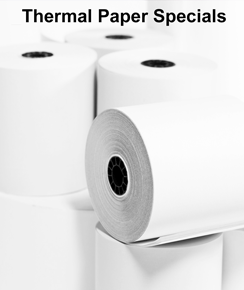Understanding the Sensitivity of Thermal Paper
January 31, 2017
Thermal paper is extremely unique, compared to traditional paper. The main characteristic that sets it apart from traditional printer paper is that it has been coated with a special chemical that reacts to heat when it reaches a set temperature. With thermal paper and thermal paper printers such as the Ingenico credit card printers, you can quietly and quickly print the needed documents, all while maintaining an image that is clear and accurate.
Even though the technology used for each type of thermal paper is similar, it varies in regard to sensitivity. There are several different grades of thermal paper, which begins with the standard POS grade that is used in most retail establishments, to a high-grade resolution sheet. You have to carefully consider what paper is right for you based on a few factors. These include:
• How the paper is going to be used
• Performance of the paper
• Cost of the paper
The print image is how the paper reacts when it is exposed to a certain level of energy or heat. The higher resolution the paper has, the crisper, darker, and longer lasting the image will be.
Thermal paper is a type of printing paper; however, within this category, there are some options to consider. For example, low sensitivity thermal paper, which is considered POS grade, is the best option for printing traditional logistics receipts, distribution print outs, picking tickets, and retail receipts. It is also ideal for printers that have a standard speed. There is no limitation related to print density, bar cold, graphics, and image stability capabilities.
Another option is high resolution or high sensitivity thermal paper. This is the better option if you are planning on printing parking receipts, thermal tickets, or bar codes. They are also the preferred option for fast speed printers. This paper is more expensive than the latter; however, the trade-off is the fact that the image produced is superior quality in both clarity and density. Also, this type of paper is resistant to fading because of humidity, heat, and light, providing you with a longer image life.
At some point, all thermal paper will fade. However, if you store the print-outs properly and handle them carefully, POS grade paper can be archived for as much as five years and high-resolution paper can retain readable images for as much as 15 years.
Thermal paper is a popular option for many businesses. The fact is it offers advantages that other types of paper and printers simply can’t match. However, within the category of thermal paper, there are certain things to consider and keep in mind. With the tips here you can find the right type of thermal paper for your needs and ensure it will last for your record keeping needs.
Thermal Paper Technology
Even though the technology used for each type of thermal paper is similar, it varies in regard to sensitivity. There are several different grades of thermal paper, which begins with the standard POS grade that is used in most retail establishments, to a high-grade resolution sheet. You have to carefully consider what paper is right for you based on a few factors. These include:
• How the paper is going to be used
• Performance of the paper
• Cost of the paper
The print image is how the paper reacts when it is exposed to a certain level of energy or heat. The higher resolution the paper has, the crisper, darker, and longer lasting the image will be.
Paper Options to Consider
Thermal paper is a type of printing paper; however, within this category, there are some options to consider. For example, low sensitivity thermal paper, which is considered POS grade, is the best option for printing traditional logistics receipts, distribution print outs, picking tickets, and retail receipts. It is also ideal for printers that have a standard speed. There is no limitation related to print density, bar cold, graphics, and image stability capabilities.
Another option is high resolution or high sensitivity thermal paper. This is the better option if you are planning on printing parking receipts, thermal tickets, or bar codes. They are also the preferred option for fast speed printers. This paper is more expensive than the latter; however, the trade-off is the fact that the image produced is superior quality in both clarity and density. Also, this type of paper is resistant to fading because of humidity, heat, and light, providing you with a longer image life.
Important Facts about Thermal Paper
At some point, all thermal paper will fade. However, if you store the print-outs properly and handle them carefully, POS grade paper can be archived for as much as five years and high-resolution paper can retain readable images for as much as 15 years.
Thermal paper is a popular option for many businesses. The fact is it offers advantages that other types of paper and printers simply can’t match. However, within the category of thermal paper, there are certain things to consider and keep in mind. With the tips here you can find the right type of thermal paper for your needs and ensure it will last for your record keeping needs.



